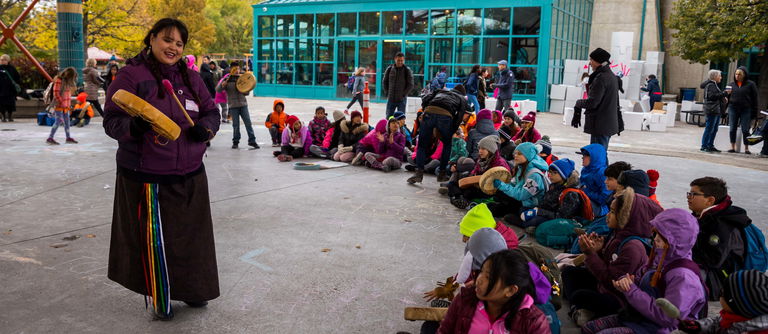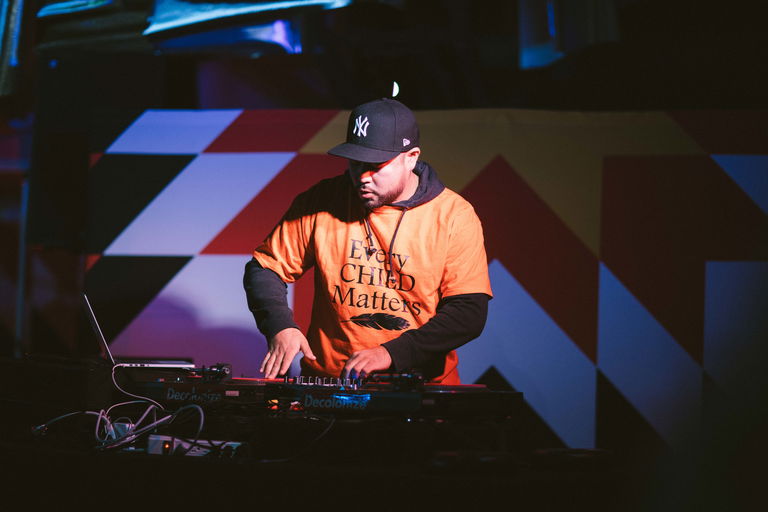Indigenous Cultural Programming
The importance of Indigenous inclusion in cultural programming cannot be overstated. In 2018, Culture Days hosted a webinar on the topic of Indigenous Cultural Programming with guest speakers Dominga Robinson, former SaskCulture outreach consultant, Christine Van der Merwe from the Multicultural Council of Saskatchewan, and Chantal Amstad from the Association Communautaire Fransaskoise de Moosejaw.
Watch the Indigenous Cultural Programming webinar.
The information on this page is based on the content of this webinar and is meant to help in the development of lasting and respectful relationships with Indigenous communities and the production of meaningful cultural programming.
Where to start
There are a few steps to take before engaging in a cultural partnership with Indigenous communities. It’s important to familiarize yourself with some basic information in order to make sure that the partnership is approached respectfully.

The Truth and Reconciliation Commission of Canada
The Truth and Reconciliation Commission of Canada (TRC) was established in 2008 to document the history and impact of residential schools in Canada. The commission made it possible for survivors of the residential school system across the country to share their experiences. This research was a mandated part of the Indian Residential Schools Settlement Agreement (IRSSA), an agreement between the government of Canada and around 86,000 former students of the residential school system. In 2015, the TRC released a final report on their findings, in which it was concluded that the residential school system should be categorized as cultural genocide. The full report can be accessed here.
Along with this report, the TRC also made 94 Calls to Action to advance the process of Canadian reconciliation and redress the legacy of residential schools. These Calls to Action are concrete actions that must be taken by all levels of government and Canadians to advance reconciliation efforts, and familiarizing yourself with them is an essential step towards building meaningful and respectful relationships with Indigenous people. Calls to Action booklets can be purchased from the National Centre for Truth and Reconciliation (NCTR) for only $7, available in both French and English. These booklets also include TRC’s 10 Principles of Truth and Reconciliation and the United Nations Declaration of the Rights of Indigenous Peoples (UNDRIP).
The Treaties
Over 50% of First Nations are Treaty First Nations. Treaties are agreements between the Government of Canada and Indigenous groups that define the ongoing rights and obligations for all sides of the agreement. The treaties are an essential aspect of how a large portion of the land in Canada has been attributed ownership. It is important to familiarize yourself with the agreements that are in place in the land that you live in. This information will also allow you to form a proper treaty land of territorial acknowledgment, which can be presented publicly before the start of the activities during the Culture Days weekend. These kinds of acknowledgments are an important part of the reconciliation process as they make us recognize the history of land claims in Canada. Here are some basic tips from University of Alberta’s Shana Dion, Assistant Dean of First Nations, Métis and Inuit students, about how to make an acknowledgement properly.
Most importantly, if you are planning a territorial acknowledgment or statement, you should consult with local Indigenous representatives or organizations so you understand the proper protocol and terms for your area or region.
Indigenous Tribes, Nations, and Clans
Although all tribes, nations, and clans fall under the more general term ‘Indigenous peoples’, it is important to acknowledge their existence as culturally distinct groups with different cultural practices. There are over 600 Indigenous groups in Canada alone. You should familiarize yourself with the specific tribes, nations or clans in the Treaty lands you reside in, especially if you are looking to collaborate on cultural programming. Learning as much as possible about local Indigenous communities’ cultures and history is an important part of the process.

Terminology
It is essential to understand what terminology is acceptable to use and which is not. Making a mistake is not the end of the world, but realizing it and then reflecting upon and learning from mistakes is crucial. Here are a few basic rules:
- Use specific tribal affiliation, when possible, rather than the general term “Indigenous person” (i.e., Anishinaabe, Nakoda, etc.)
- “Aboriginal” is an outdated term, which is being phased out
- Understand the distinctions between First Nations, Métis and Inuit peoples
- Never use the term “Indian” unless referencing an official document like the Indian Act
- When in doubt, ask people how they would like to be addressed, they will tell you
Here are some terms and expressions, among many more, that should not be used:
- “Our” Indigenous peoples
- “Let’s have a powwow”
- “Low on the totem pole”
- “Off the reservation”
- “Indian name”
- “Indian time”
- “My spirit animal”
- “On the war path”
- “Too many chiefs, not enough Indians”
The benefits of inclusion
The process of Indigenous inclusion requires effort because of the barriers that have been put up over time. There are great benefits to breaking down these barriers. This is a community-building process that helps advance reconciliation efforts, erase stereotypes, and create new relationships within the community. As a result, this will build new audiences for your events and activities as well as a new group of potential volunteers. Engaging in meaningful Indigenous cultural programming will broaden and strengthen your community, and help you avoid “tokenism”, which is when Indigenous people are involved at only the most superficial of levels. People who feel represented within an organization are more likely to participate, and this participation will in turn greatly benefit the organization. As we adjust our programming and build these relationships, we increase our diversity and intercultural competencies, making for stronger, more inclusive work. While avoiding cultural appropriation and working towards reconciliation should be an ongoing effort, having Indigenous peoples involved in programming can help all of us engage more actively in these efforts as we have much to learn from those communities.

What is cultural appropriation?
Cultural appropriation is one of the many ways that imbalances of power between non-Indigenous and Indigenous cultures becomes evident. It’s important for us to understand what it means in order to make sure we do not engage in such practices. Cultural appropriation is the adoption of elements from a minority culture by a majority culture. This becomes especially problematic when the elements that are being appropriated are stripped of the meaning they hold for people of its original culture, or are being used for financial gains. This can refer to language, visual arts, music, clothes and many more aspects of a culture. For example, design elements from Indigenous clothing being used to create “exotic” fashion bought and worn by people who have no connection to their original cultural context. This is a complex topic and one where many grey zones exist. It is therefore very important to keep discussing it and most of all to remain self-critical of our actions.
In 2018, SaskCulture organized a panel discussion about cultural appropriation, which dives deep into the topic. The speakers were Audrey Dreaver, Michelle LaValley, Janet Rogers, and Trudy Stewart, who all work in the arts and culture sector. You can watch the full video here.
Relationship building
Understandably, there are many challenges to building meaningful relationships with Indigenous communities given the colonial history of Canada and its treatment of First Nations, Métis and Inuit peoples. It’s going to take time and effort. We cannot expect this to happen over a single meeting, and it’s always better to meet people face-to-face as it will make breaking down these barriers easier than over the phone or by e-mail. Asking questions in a respectful manner is an important part of the process. However, educating yourself before meeting with Indigenous peoples is crucial as asking very obvious questions shows that you have not taken the time to acquaint yourself at the most basic of information. It’s important to understand that building a relationship with you may not be a top priority in the community at that particular moment and being respectful of that fact will go a long way. When it comes to cultural programming, inviting Indigenous peoples to be part of the planning from the start is essential. This helps build a process where Indigenous people can contribute to programming instead of simply being told what is required of them. We must create space for flexibility and compromise. At the end of the day, it’s important to be respectful, compassionate, and to listen. If we do all these things, we can work towards removing the longstanding barriers that have prevented authentic relationship-building with local Indigenous communities and peoples.
This resource presents only some of the basic information for engaging in cultural programming with Indigenous people. It is in no way comprehensive but we hope it is a good starting point. There are many more resources to be accessed. A good place to start is Indigenous Corporate Training inc., an organization from British Columbia that specializes in developing relations between non-Indigenous and Indigenous groups. Most of the information on this page was provided by SaskCulture staff. You can and a number of other useful resources on their website.
Here are some other useful resources:
Crisis services hotlines:
- Indian Residential School Survivors and Family Hotline: 1-866-925-4419
- Crisis Services Canada: 1-833-456-4566 or text 45645;
- Kids Help Phone: 1-800-668-6868.
- First Nations and Inuit Hope for Wellness Help Line: 1-855-242-3310.
- Native Youth Crisis Hotline: 1-877-209-1266.